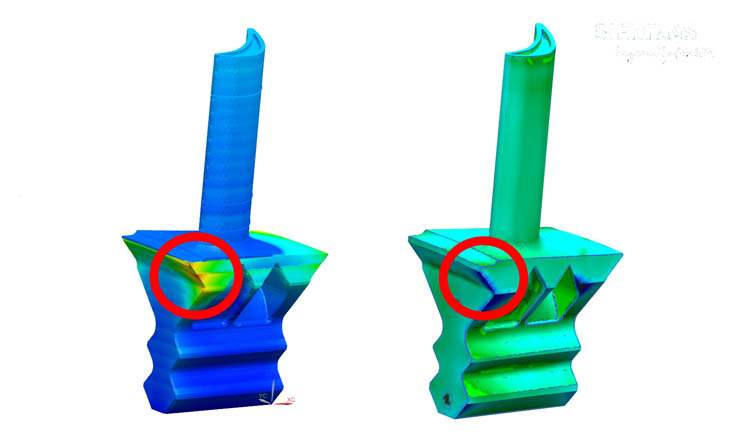 Siemens, which already offers several simulation software products, is introducing a new Additive Manufacturing Process Simulation solution for the purpose of predicting distortion during 3D printing. The product uses a digital twin to simulate the build process prior to printing, anticipating distortion and compensating for it by generating a corrected geometry. It’s intended to help manufacturers get a perfect print on their first attempt, reducing waste of material, time and money.
Siemens, which already offers several simulation software products, is introducing a new Additive Manufacturing Process Simulation solution for the purpose of predicting distortion during 3D printing. The product uses a digital twin to simulate the build process prior to printing, anticipating distortion and compensating for it by generating a corrected geometry. It’s intended to help manufacturers get a perfect print on their first attempt, reducing waste of material, time and money.
“Using the Simcenter 3D AM Process Simulation solution at toolcraft will allow us to complete our additive manufacturing workflow,” said Christoph Hauck, managing director, MBFZ toolcraft GmbH. “Through real-world testing, we have gained confidence that the Siemens AM Process Simulation solution will assist us in ensuring quality output from our print process.”
 Heat is generally used to fuse layers of a metal 3D print, and as those layers build up, the residual heat can cause parts to warp inside the 3D printer. This can result in everything from structural issues to total print failure. It can be a major issue that can be difficult to avoid without simulation, making a solution like this one extremely valuable. The new process simulation product is integrated into the Powder Bed Fusion process chain in the Siemens PLM Software Additive Manufacturing portfolio. It provides a guided workflow to the user that allows for the assessment of distortions, the prediction of recoater collisions, prediction of areas of overheating, and provides additional valuable information about the 3D printing process.
Heat is generally used to fuse layers of a metal 3D print, and as those layers build up, the residual heat can cause parts to warp inside the 3D printer. This can result in everything from structural issues to total print failure. It can be a major issue that can be difficult to avoid without simulation, making a solution like this one extremely valuable. The new process simulation product is integrated into the Powder Bed Fusion process chain in the Siemens PLM Software Additive Manufacturing portfolio. It provides a guided workflow to the user that allows for the assessment of distortions, the prediction of recoater collisions, prediction of areas of overheating, and provides additional valuable information about the 3D printing process.
The new product allows manufacturers to iterate on a solution between the design and build tray setup steps and the simulation step. According to Siemens, this closed feedback loop is possible thanks to the tightly integrated nature of the company’s digital innovation platform. The simulation data feeds into the digital thread of information, which informs each step of the 3D printing process.
What Siemens calls a “digital backbone” allows the system to develop pre-compensated models and to feed them seamlessly back into the model design and manufacturing processes without additional data translation.
“This solution is the latest addition to our integrated additive manufacturing platform, which is helping customers industrialise additive manufacturing by designing and printing useful parts at scale,” said Jan Leuridan, senior vice-president for Simulation and Test Solutions at Siemens PLM Software. “By using a combination of empirical and computational methods we can increase the accuracy of the simulation process, feeding the digital twin and helping customers better predict their real-world print results. We have proven this over months of real-world testing with some selected first adopter companies. Providing corrected geometry and closed loop feedback can ultimately allow our customers to get better results from their additive manufacturing processes, helping to achieve that first-time-right print and realize innovation with this technology.”
The AM Process Simulation solution is expected to be available in January 2019, as part of the latest NX software and Simcenter 3D software.
Discuss this and other 3D printing topics at 3DPrintBoard.com or share your thoughts below.
Subscribe to Our Email Newsletter
Stay up-to-date on all the latest news from the 3D printing industry and receive information and offers from third party vendors.
Print Services
Upload your 3D Models and get them printed quickly and efficiently.
You May Also Like
Reinventing Reindustrialization: Why NAVWAR Project Manager Spencer Koroly Invented a Made-in-America 3D Printer
It has become virtually impossible to regularly follow additive manufacturing (AM) industry news and not stumble across the term “defense industrial base” (DIB), a concept encompassing all the many diverse...
Inside The Barnes Global Advisors’ Vision for a Stronger AM Ecosystem
As additive manufacturing (AM) continues to revolutionize the industrial landscape, Pittsburgh-based consultancy The Barnes Global Advisors (TBGA) is helping shape what that future looks like. As the largest independent AM...
Ruggedized: How USMC Innovation Officer Matt Pine Navigates 3D Printing in the Military
Disclaimer: Matt Pine’s views are not the views of the Department of Defense nor the U.S. Marine Corps Throughout this decade thus far, the military’s adoption of additive manufacturing (AM)...
U.S. Congress Calls Out 3D Printing in Proposal for Commercial Reserve Manufacturing Network
Last week, the U.S. House of Representatives’ Appropriations Committee moved the FY 2026 defense bill forward to the House floor. Included in the legislation is a $131 million proposal for...

































